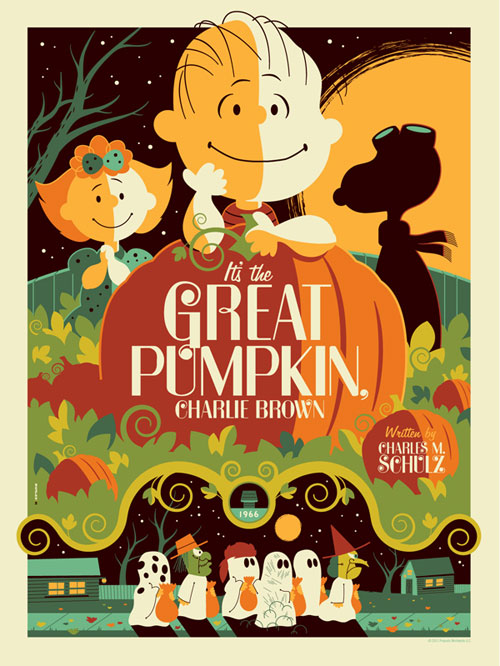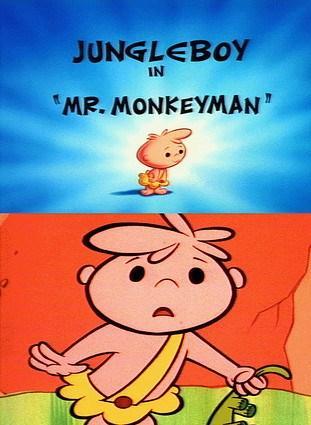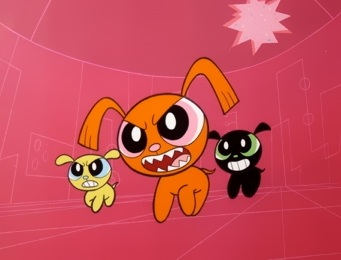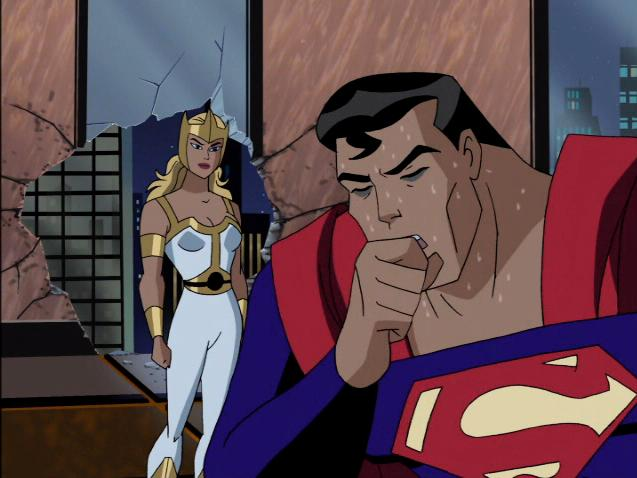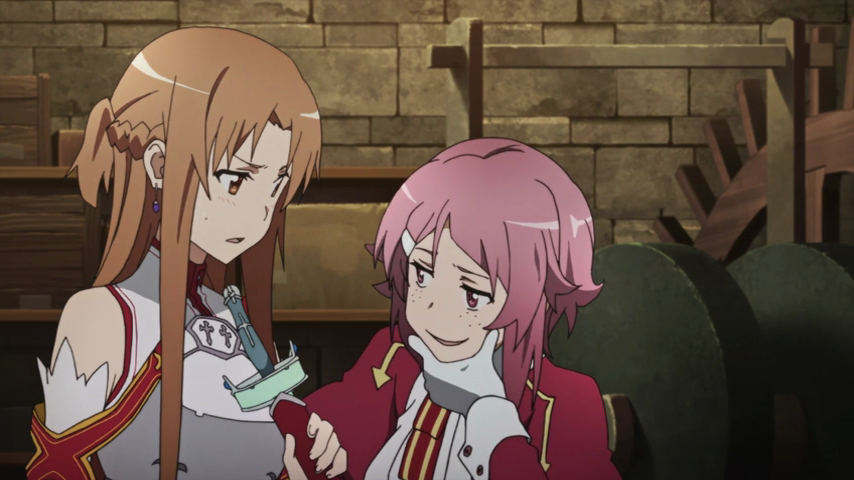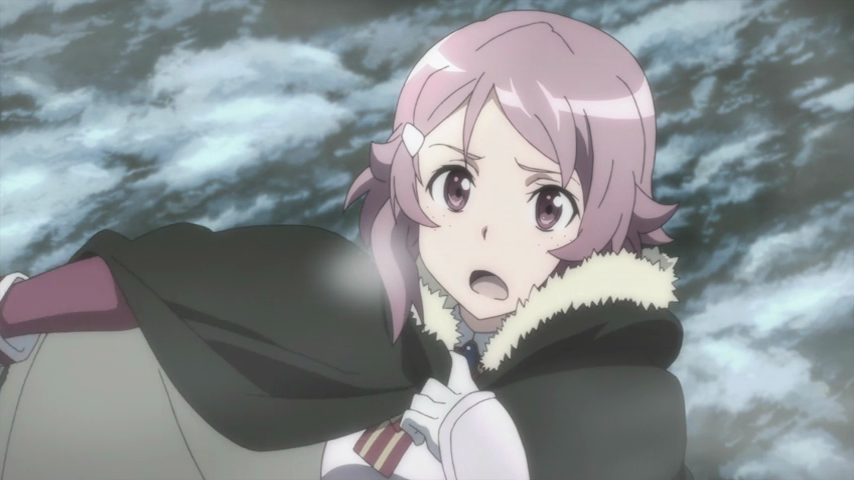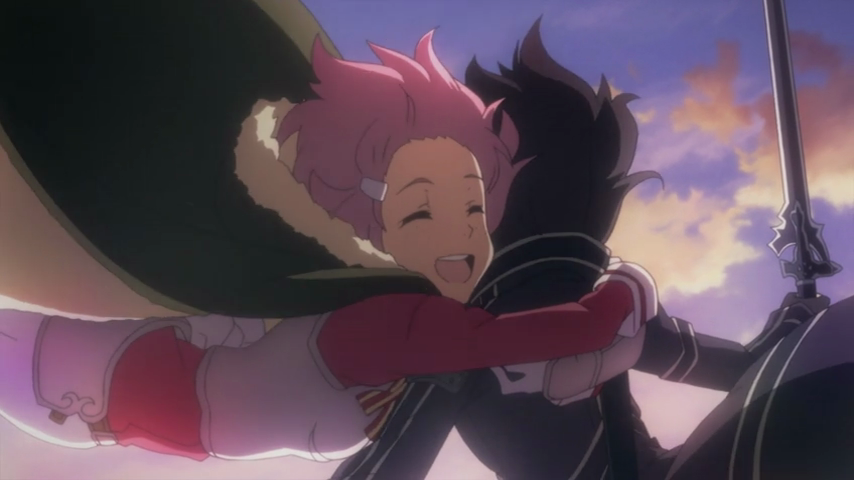Hey guys, Foggle here! This season’s installment of the clusterfuck is a bit late (my bad on that!), but hopefully you’ll still enjoy reading our opinions on some of this fall’s shows. And sorry about missing summer 2012… it won’t happen again (as far as you know)!
Btooom!
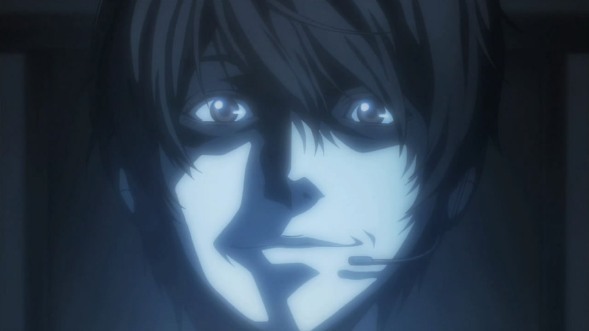
I believe Light Yagami has grounds to sue....
No, this isn’t the synopsis to the next Michael Bay movie. Instead, its the title of yet another anime series about people getting trapped in an online game having their lives affected by it for real. BTOOM! itself is the title of this fictionally popular MMO action game which seems to be some weird combination of a Call of Duty game mixed in with Bomberman, but in case I gave you the mistaken impression of something that sounds awesome, think more along the lines of Bomberman: Act Zero….yeah, that’s supposed to be the hugely successful game that apparently every gamer in this world is hooked on.
The main character of this series that I guess we’re supposed to identify with and care about is, Ryo-ta Sakamoto, a self-proclaimed expert at this game who isn’t the slightest bit shy to brag about how awesome he thinks he is. After successfully leading his team to victory in an online match, we suddenly flash to Ryo-ta dangling off a tree in a jungle-like area, attached to a parachute. This is done without much of any transitional effect at all so there really isn’t any dramatic impact to this scene, and it plays out pretty much how you would expect. Sakamato gets himself loose, questions just how the hell he got to where he currently is, stumbles about and starts trying to look for other human contact. After arriving at a beach he inspects his bag and finds that bombs have mysterious been placed inside it, and recalls a bit of what happened between the last time we saw him in the real world and his present situation. In this scene we get something that’s actually remotely interesting in telling us something unique about this character, when he scolds his mother for sending his resume to a grocery store which he has no interest of working at, claiming that he is already trying out for another job of his own interest. This at least shows some dynamic to his character in the real world, and it would be nice if this anime could break common molds and genre conventions and try to actually let us know about the personal issues of this character, but this is quickly forgotten as we go straight back into the virtual world where things just play out by the standard guidelines.
Ryo-ta discovers that he has bombs in his bag, and is then attacked by bombs from another player. Rather than having some interesting interaction between Ryo-ta and his first human contact, the encounter just plays out like you’d expect. The attacker is some generic bad guy who laughs maniacally as he throws bombs at Ryo-ta and misses countless times. At one point he even corners Ryo-ta by having a bomb in each hand so that he can throw one at Ryo-ta and the other at the only place that he can evade to….but then he announces his plan to Ryo-ta and as you can expect, falls into a predictable trap and dies. Ryo-ta vomits after realizing that he’s just killed another human being for real (though I could’ve certainly been fooled as the guy acts as 1-dimensional as any generic enemy in a video game would), and then the end credits role.
You want to know the fucked up thing?….That’s not even the end of the episode. There’s more stuff after the end credits, and I don’t just mean like a few seconds leading up to the next episode. I mean like 5 fucking minutes of more material past the end credits. And you want to know what else? These few minutes contain the most essential scenes of the episode. We get to learn more about just what kind of job Ryo-ta was trying to get, we gain more insight about his relationship with his mother, and we see some actual analysis of his character in real life. Unfortunately the majority of this episode is just a “by the book” follow-through of what you’d expect of a series of this genre. Its the most generic anime of this sort that I have seen, and while it does have a few hints of having more than just a 2-dimensional main character, it opts out to go the predictable and conventional route whenever you get close to giving two-shits about Ryo-ta (after all, he’s only the main fucking character).
Really, with a title like BTOOOM!, you’d expect something that goes all out and extreme. It’d probably be something goofy or absurdly stupid, but the last thing you’d expect it to be is flat out boring. If its extreme at anything, then it would be the art of being mediocre. Yes, I could indeed say that this is an anime that takes blandness to the extreme. That isn’t to say that anything about it is particularly bad, but for the life of me I can’t find a single thing I saw in it that I’d find memorable enough for me to even recall by tomorrow morning.
Unless you REALLY just love this sort of “kids getting stuck in a game and killing other people in the game for real scenario,” and don’t want to see any new takes on this pretty tired genre, I’d say that this one is a definite pass.
4/10 – Ensatsu-ken
Chuunibyou demo Koi ga Shitai!

Farscape: The Anime took some liberties, didn't they?
Well, Kyoto Animation realized it was too good to animate Key works, only to make a show about some schmuck who doesn’t know how to make friends. Complete with wavy fingers, ass shots, blank stares, Sailor Moon poses, and the rest of that shit cute girls do. They clearly made an improvement here, didn’t they?
Like a certain other anime about kids who don’t know how to make friends, Yuuta kind of sucks when it comes to being sociable. Not because of a being a douche, but more out of an inability to see the world as normal no matter how hard he tries. The characters bask in fantasy while talking about Dark Flame Masters and Wicked Eyes, while the Yuuta is still self-aware enough to know how silly it is to say it out loud. Of course, the girl has to act like a goddamn loon akin to those John Titor-obsessed bastards unable to recognize a joke for what it is. At least the show has the right mind not to treat a girl with all-but-stated mental disorders as some fetish, by portraying her as bizarre and not particularly liked even in-universe. Alas, the episode obsesses over how many weird things this girl can do in less than twenty minutes. It doesn’t feel witty, but more like something were expected to point and laugh at. It’s still a step up from expecting the audience to masturbate to this, but the idea that eccentricity should be mocked and treated as just some childish trend that will fade away soon just seems kind of cruel on KyoAni’s part.
To be more redeeming, the show can be seen as how teenagers desperately try to abandon fantasy in favor of just living among the normal. And in the cases of the cast, this desire fails because of their inherent nostalgia for being wild and dreaming of swords and sorcery. The desire to be wanted in society contrasts with the need to be one’s self, and KyoAni brings an interesting topic to the foray: Is it better to laugh alone or be miserable among many? While it’s probable that the show will devolve into another moefest, Chuunibyou has that subtle wit unable to be found in other slice-of-life works. And for that, I salute them.
8/10 – Dr. Insomniac
Ixion Saga DT

A graceful entrance.
What’s with all these (not)hack//ANIME as of late? Is the idea of getting trapped inside a video game really all that interesting? Nevertheless, Ixion Saga appears to be a slightly fresher take on the overall concept than its contemporaries… meaning that it’s a lighthearted, campy comedy. It’s not a particularly funny or creative comedy, but at least it doesn’t try to use RPG mechanics as a means for creating drama.
Hokaze Kon is a major Monster Hunter fan who gets sucked into the world of a role-playing video game office chair first after a flirtatious encounter with a buxom bimbo. Landing on a bad guy’s head during a rather anticlimactic encounter, he parties up with Steel Sainglain and Mariandale, who are out to help eight-year-old princess St. Piria get married so as to promote peace and prosperity and blah blah blah. The plot is more of an excuse to send the protagonist off on an adventure and tell some cheap jokes than anything else, as to be expected of an anime based on a video game (Capcom’s Ixion Saga, apparently).
Perhaps the most extraordinary thing about this series is how it proves that Brains Base is actually capable of producing something with absolutely awful animation and only mediocre artwork; I honestly thought this was a JC Staff or Studio DEEN production at first. The characters all look marginally good, if generic (the antagonists are very Team Rocket-esque), and no one ever goes off-model from what I can tell, so at least BB can say they have a one-up on DEEN there.
While the animation is horrible, the characters aren’t very well written, and the humor isn’t at all smart, DT has a certain air about it that makes it hard to outright dislike. Maybe because it knows it’s bad and is obviously trying its damnedest to be as campy as possible, this first episode is fun enough to sit through without hating yourself for it. You’ll probably laugh at least once, but you’ll have no interest whatsoever in watching another episode, so it’s a pretty safe time-killer.
And hey, there are worse ways to spend 24 minutes… a certain other “trapped in a video game” show, for example. 4.5/10 – Foggle
JoJo’s Bizarre Adventure
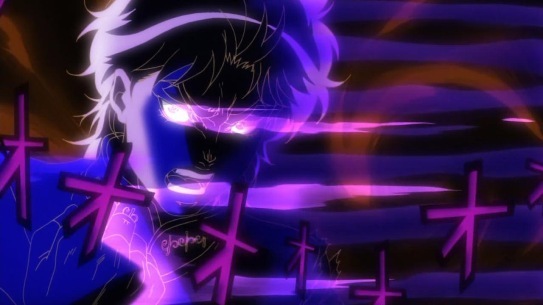
The title doesn’t lie.
For a manga series that has been in serialization since before I was even born, its curious as to how little attention it has received in the form of anime adaptations (the only one that I’m aware of was a 13 episode OVA series that was released around the early 90’s). The series itself started out as a serialized manga in none other than the incredibly popular Weekly Shonen Jump in 1987, and since then has jumped to another manga magazine (a seinen magazine at that), and has undergone various different title iterations which I assume continue the story further along. Collectively the series has released 107 volumes making it one of the longest running manga serializations out there in Japan, with only a few series surpassing its record. Of course, if you wanted a history lesson you could just go look up most of the background info of this series on Wikipedia. The real question you must be asking his, how is this anime, or at least its first episode?
Well, having never read any of the manga, nor having seen any of the OVAs, I went into this feature blind, so I can’t judge this series in comparison to its manga or OVA counterpart, but rather only on its own merits. Being a complete sucker for old-school shonen series, though, I can tell you right off the bat that this series knows how to hook my type and what I saw of this first episode was highly enjoyable. However I must go into more detail about just what I enjoyed about it, but also point out the things that bugged me.
Now, being that this series starts out this story from the very beginning (which I assume is the starting point of the manga serial), it is essentially adapting relatively old source material with a very different art and story-telling style than what most shonen-happy fans are used to seeing these days. The staff that worked on this production is clearly aware of this, and rather than try to mask that they are adapting a decades’ old work, they fully embrace it and effectively stylize this anime around that fact. This is completely showcased in the animation, in which much like an old-school late 80’s or early 90’s feature, characters in this series will over-emote every kind of expression from anger to laughter, and the mood and tone of a scene will be futher emphasized through the use of bizarre color-palettes overlaying the imagery combined with very stylish manga-like sound effect texts being displayed on a moments notice whenever a big punch or kick is thrown, or some dramatic physical effect takes place.
The main indication that reveals the intention of this anime, though, lies in the characters. From start to finish all of these characters are 100% archetypes, and to the anime staff’s credit they know this very well, and in a very clever way manage to play this element out to its extreme. The story itself starts with the sleeziest, ugliest possible old guy you could think of, going by the name of Dario Brando, coming across a wrecked carriage with 2 dead passengers, one of them being a mother with her baby still alive and crying, and the only other survivor is the boy’s father, George Joestar. The first thing the guy can think to do is loot the carriage and scram, but In a delusional state George Joestar stirs, and somehow believes this man to have rescued him and promises him that he will return the favor one day. Dario of course does not deny anything in hopes of taking full advantage of this scenario at some point in the future. After this opening scene, a dozen years pass and Dario looks even more pathetic before as he is slowly laying to waste on his deathbed in a ratty, broken-down town. It is at this point that he reveals to his teenage son Dio Brando that the very wealth George Joestar owes him a favor (why he never captialized on this before is never explained, but perhaps the guy has enough of a heart to put his young son’s interests over his own for all I know), and tells him to go to him in hopes that his son can use his power and intelligence to inherit all of Joestar’s fortune. Dio decides to honor his father’s request….in a scene where he stands at his grave, spits on it, and kicks some dirt at it. Right from the get-go this series makes it completely clear that Dio is going to be the main antagonist of this story, and I can’t think of a more appropriate way to portray that fact.
George Joestar welcomes Dio to his family with open arms, of course. Now, the problem for Dio is that he has some competition in the form of George’s now grown son, Jonathan Joestar, who is around the same age as Dio. Upon the introduction of his character, the story makes it clear that while Dio is basically being geared up to be the ultimate evil of the series, Jonathan is the pure, chivalrous good-guy. He fights to protect a woman when he sees her being bullied by a couple of punks (albeit in an effort that gets him roughed up, as it is indicated that he is not very strong as this point in the series), and just about everything this character says or does indicates you that he’s a goody-goody to the extreme. Essentially, this show is setting up the inevitable rivalry between Jonathan and Dio to be the ultimate battle of good vs evil. And surely enough, upon Dio’s arrival, he makes it abundantly clear that he is not there to make friends with Jonathan, but rather to take his place and become the true inheritor of George’s wealth and prestige.
This is where the episode, while still good, begins to falter a bit for me. The second half of the episode really rushes things (I would assume it inevitably cuts out several scenes from the manga), and chronicles the growing antagonism between these 2 very opposite entities. Dio basically does everything in his power to make Jonathan’s life a living hell. At first he starts out with small things like belittling Jonathan by doing far better than him in his studies and showing far more sophistication and manners expected of a noble, which George has no problem pointing out to Jonathan with phrases such as “Why can’t you be more like Dio?” After a little while, this doesn’t seem to be enough for Dio and he ends up going a step further by humiliating Jonathan in a public fist-fight and by spreading dirty rumors about him. As time passes by, this even further escalates to Dio forcefully kissing Jonathan’s girlfriend and then assaulting her with a hard punch to her face after she tries to wash her lips from the disgust of coming into contact with him. This of course was going too far which finally provokes Jonathan to assault Dio, only for Dio to make himself look innocent and get Jonathan punished by his father. As if that weren’t enough, he then proceeds to BURN JONATHAN’S DOG ALIVE! And its at this point that you can tell that their rivalry has culminated into pure hatred for one another, and you can only expect epic battles from them in the future. The episodes ends after this point by indicating a 7-year time-skip signifying the adulthood of these 2 adversaries.
These highly emphasized, yet essentially 1-dimensional, characters are handled by some excellent voice-acting talent. The Seiyuu do a great job of capturing the stone and mood that this anime is going for, playing lines straight most of the time but not shying away from the over-emoting when the series calls for it, and they do so in such a way that it really made me feel like I was watching something straight out of the 80’s at certain points in time. Dio in particular has a suitably deep and threatening tone, but also one with some clear intellect behind it which suits his character, who aside from being all-out evil is also smart enough to analyze that his weakness is his temper and his lack of ability to control his emotions, whereas Jonathan’s strength is in how he becomes stronger after every time he’s knocked down (which is an archetype that nearly every single shonen protagonist in existence follows).
Overall it was an enjoyable if somewhat static first episode. In this regard, though, the show is clearly meant to be black and white and it certainly doesn’t shy away from presenting its material in that manner. That said, it could perhaps be a little bit too stylistic for its own good. I thoroughly enjoyed what I saw, but the over-emphasis on some of these shallow elements can be a bit overbearing and actually mark them out more as flaws than intentional design at some instances. Even so, if you like the idea of a classic good and evil story-line with the elements of good and evil and everything surrounding those archetypes stretched out to their most extreme, than you can be sure that you will find something to like about this series, or at least this premiere episode. JoJo’s Bizarre Adventure: The Animation is clearly an anime that’s not intended for everyone, but if you consider yourself a fan of a old-school shonen series, then this series is definitely worth giving a look.
8/10 – Ensatsu-Ken
Second Opinion!
There’s really nothing else quite like JoJo’s Bizarre Adventure. A shounen action epic that simultaneously appeals to both diehard shounen action fans and unflinching shounen action haters, this unique behemoth of a manga has been going strong for 25 years and attracted many fans. Even in the first episode of this inevitable anime adaptation, it’s not hard to see why.
A silly prologue sets up the story, and within minutes the wheels are already turning with full force; Dio Brando moves in with Jonathan “JoJo” Joestar and his father, and proceeds to make JoJo’s life hell… all for the sake of cash. Dio’s plan is to completely ruin JoJo emotionally, thereby making him appear weak, so that he can inherit the Joestars’ rather large sum of money. The breakneck pacing, goofy plot points, and over the top action sequences never miss a beat, ensuring that viewers’ eyes stay glued to the screen at all times. The smooth animation and zany visual effects truly are bizarre and heighten the experience even further. Better still is the hilarious voice acting that will no doubt make you laugh on at least one occasion.
E-K already did a much better job describing this first episode than I ever could, so there isn’t much else I can say except that it’s awesome. If you like your ultra-manliness with a generous side of insanity, this’ll be right up your alley. 9/10 – Foggle
K

K.
What the fuck is this? No, seriously, what the heck did I just watch? Between the nonsensical magic fights, the fujoshi-pandering character designs, and lack of explanation for any of the major plot points or backstory, I found myself lost and confused throughout roughly 70% of this first episode. Perhaps this is for the best, as the plot so far seems to be naught more than an excuse for hot guys to get into slightly compromising and oftentimes violent situations by whatever means necessary.
The episode begins with a group of teenagers breaking into a (presumably American) businessman’s high-rise apartment and beating him up, then questioning him about… something… in decently constructed Engrish. An 8 year old girl in gothic lolita clothing stares intently at a marble and they leave. An army of cops are waiting for them in the lobby, so they decide to fight. The gang leader glows with a red aura while the cops glow with a blue one, and then it cuts to the OP.
Commencing with the obligatory high school slice of life setup, the rest of the episode follows lighthearted protagonist’s Isana Yashiro’s adventures in bumming food off of his classmates and napping on the roof of a large building. Androgynous character design aside, I actually kind of liked this guy, as he seems to be a pretty okay dude. Eventually, he is sent to the store by the student council, and that’s where things get weird again. The guys from the opening segment try to kill him, but he’s saved by an even more androgynous man in a scene definitely intended as ship bait, who then also tries to kill him not minutes later. The reasoning behind this is revealed as cryptically as possible, and apparently that’s a wrap. Maybe this is the intended effect, but the majority of this first episode is downright incomprehensible as of right now.
Now, say what you will about its confusing storytelling and interesting manner of pandering, but one thing about K is undeniable: it’s damn stylish. The backgrounds are beautifully drawn, and the sweeping vistas scattered throughout the episode will make you gaze in awe. At times, some kind of blue filter appears to have been applied over the artwork, giving the visuals a nice cool feeling. And the music – vocals in the OP aside – is fantastic and easily the highlight of the entire episode. The show itself may be nothing special so far, but it sure looks pretty and the OST is nothing short of excellent. The animation is also quite fluid, though several pieces of dialogue are noticeably missing mouth movements.
My thoughts on K can be adequately summed up by my reaction to the unexplained naked chick floating around a staircase halfway through the episode: a blank look on my face and a simple “what.” 5/10 – Foggle
Little Busters!

The finest in biological warfare.
I have seen nearly every Key anime, and hated all of them. I can’t understand the appeal behind Clannad, and Angel Beats! is one of the most abominable things I’ve ever witnessed. So it may come as a shock to you that I actually did not despise the first episode of Little Busters! – in fact, I quite liked it.
Let’s just get this out of the way first. Yes, the main character is a man voiced by Yui Horie (seriously, WHAT?). Yes, it features some of that cringeworthy female-on-male violence = comedy nonsense. Yes, an early flashback scene is saccharine enough to cause diabetes. Yes, the music sounds like it was ripped directly from the Nintendo eShop. And yet, unlike Key’s previous works, there’s actually more to Little Busters! than that… or, at least, the first episode creates the illusion of such.
This first installment serves mostly to introduce us to the five primary characters. A bit of a mixed bag, as Rin is exactly the kind of person I hate in shows like this and Riki I couldn’t bring myself to care about, but I quite enjoyed the personalities of Masato, Kengo, and especially Kyousuke. A huge problem I have with this kind of series is unrealistic characters, but I actually knew a guy in high school who was almost exactly like Kyousuke, which brings about fond memories of days (not so) long past. While a lot of the jokes are fairly obvious, the character interactions were quite fun throughout, though I can’t help but think that it would have been far better had a larger focus been placed on the bromance.
The pacing is fast and sharp. Not a lot happens in Little Busters’ first outing, but almost none of the 24 minute runtime feels wasted on lingering shots or unnecessary dialogue. The initial scenes are attention-grabbing and expertly used to the episode’s advantage, successfully capturing the interest of even someone like me who went into the show fully expecting to hate it. Music aside, JC Staff’s production on this title is quite admirable and unusually high quality by their standards. The voice acting and aforementioned direction are great, while the art and animation remain above average at all times (believe me, that’s high praise for something by JC Staff).
In spite of some shaky moments – the final scene unfortunately makes it look like the next installment might head into some familiar and awful territory – this first episode managed to impress me. Not enough to heap praise upon it or forgive Key for 2002’s Kanon anime, but certainly enough for me to recommend their latest foray into the medium of animation. Maybe I’m going crazy. Maybe my expectations were just so low that anything would have exceeded them. Maybe Key fans will hate this series as much as I hated Air. Or maybe, just maybe, Little Busters! really is as good as I’ve heard.
Only time will tell. 8/10 – Foggle
Medaka Box Abnormal

Balls of steel.
I didn’t think it was possible, but somehow Medaka Box has managed to become worse over time. While the first season was a bad comedy with an occasional actually humorous joke lifted from other, better anime, season two is a bad action show with almost no jokes in it. Unless I missed something, it takes roughly nine minutes of the 23 minute runtime for the first bit even resembling humor to pop up, and by that point I had almost fallen asleep. Medaka Box Abnormal is dreadfully boring even by generic shounen action standards, and too devoid of laughs to even be considered a parody like the first season ostensibly was.
This episode opens with some exposition explaining why Medaka is so good at everything she does. Then there’s some more exposition setting up the central conflict that will likely be present for the rest of the season. This drones on for an eternity, to the point where episode one is almost halfway over by the time anything actually happens. And what actually happens? The hero gets her ass kicked by an incredibly annoying loli character who speaks in random strings of numbers because why not? This “gag” wears out its welcome 15 seconds in, so of course it persists throughout the next ten minutes, delivering a grand total of zero laughs overall.
In fact, outside of one fairly obvious joke near the end, this episode never so much as made me grin. The action is horrible, the humor is nonexistent, and the audience is given no reason whatsoever to care about the characters. There’s still a large amount of fanservice, and the music still sounds like a Pokemon OST, but the art and animation have taken a complete nose dive since Medaka’s previous outing. The animation and colors are nowhere near as vibrant or eye-popping as they once were, and the character designs have become absolutely awful. They’re clearly over the top on purpose in an attempt to parody various popular shounen action series, but that doesn’t stop them from being downright ugly. Of course, it would probably help if this show was anywhere near as good as any of the anime it’s making fun of, but it’s really not. Yes, even Naruto and Bleach are far superior to Medaka Box.
The only thing abnormal about this show is just how uninteresting Gainax has managed to make an action-comedy. 3/10 – Foggle
Onii-chan Dakedo Ai Sae Areba Kankeinai yo ne (OniAi)

The exact opposite of my reaction to this episode.
The title of this anime roughly translates to As Long As There’s Love, It Doesn’t Matter If He’s My Brother, Right?. 1/10 – Foggle
Ahem. OniAi is a show about a 16-year-old girl who wants to fuck her brother. In a shocking twist of fate, they actually are blood-related, and he doesn’t want the sex, nor does he have any perverse inclinations toward the concept. It’s also a harem and (relatively mild) ecchi series, as if the core concept wasn’t brain-bleedingly terrible enough. In the end, it’s not funny, the girls are all obnoxious, only one of them isn’t a total creep, and the art is often ugly.
OniAi’s writing makes Baka to Test look like Fumoffu. The one-note jokes are all boring, lacking in wit, timing, or originality. The girls are all the exact opposite of who you’d want in your harem. The male protagonist barely qualifies as a character. There really is nothing to like about this series unless you have a sister complex or prefer your girls on the “I sacrifice live goats in your honor every weekend” side of weird. Seriously, Ana’s dialogue and vocal tone borderline on serial killer territory at times. When the various love interests aren’t acting deranged, they’re being obscenely annoying, screaming their lines into the microphone in an attempt to imitate a Butch Hartman cartoon. Akiko, sister to Akito (the titular onii-chan), is the worst offender in this regard. She yells at least half of her dialogue, almost all of which is related to being wet for her big bro in some way.
The art ain’t so hot either. While the target audience is likely expected to use OniAi as wank material, it’s hard to imagine anyone masturbating to these character designs, especially when so many of their facial expressions are outright horrible to look at. See that image of Akiko up top? She wears that same godawful smile for roughly 70% of this episode. Be still my beating heart.
Do yourself a favor and stay away from this show. If you were planning on watching it at all in the first place, please just stop lying to yourself… you know you’re only in this shit for the doujins. 1/10 – Foggle
Psycho-Pass

Like you'll ever get biceps like these.
Over a year ago, a man made an odd magical girl show that somehow sold gangbusters. With clout and the phone number of the woman who makes Hitman Reborn in hand, he decided to make his own cyberpunk anime, otherwise known as PSYCHO-PASS. Unlike his previous shot on TV, he makes no illusions about what it’s really like: A grim and cerebral cop drama walking in the footsteps of Stand Alone Complex.
In all honesty, it owes quite a bit to Ghost in the Shell. The CG vehicles, oblique exposition, and overall morally ambiguous feel definitely pay tribute. There are even a few shots that look ripped right off of Blade Runner and Minority Report. That might be a point off for unoriginality, but it still shows promise to portray a genre long thought to be in autopsy. Really, it’s even a bit flattering to see a Japanese show pay tribute to work from our side of the coast.
However, there’s an extra spanner in the works, as the protagonists have to utilize a gadget that aims based on the personality of the one they’re gunning for. And even the cops themselves can be targets ready for the kill, whether or not they even know it.
However, the aforementioned writer isn’t really known for distinct characterization. There isn’t much yet to differentiate the characters from other archetypes. You get the naive newcomer, the battle-scarred veteran, and so on, but will they have potential to grow into something greater? Whatever gray resolution to bleak executions such as the one portrayed in this episode has been done before, and the show definitely hasn’t broken new ground from the start. But then again, it’s only at the start. As its predecessor has shown, there’s plenty of room to utilize the potential that it’s laid out for us.
9/10 – Dr. Insomniac
Resident Evil: Damnation
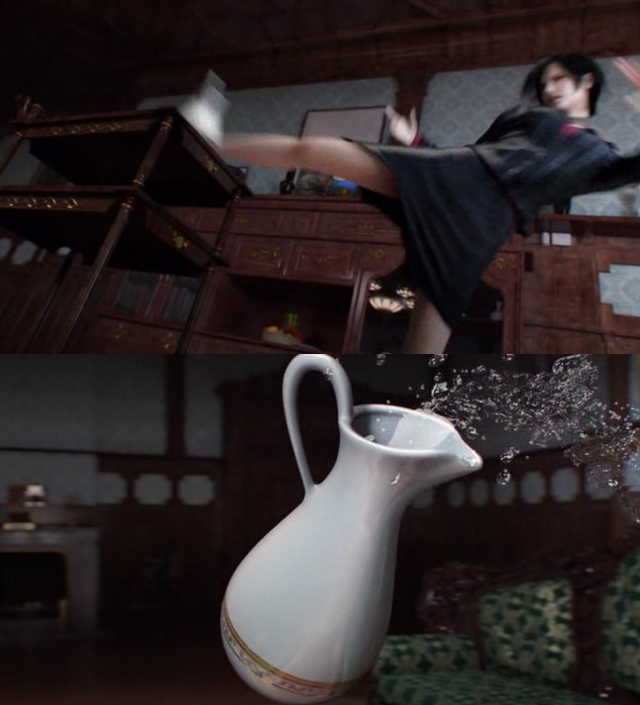
Survival horror at its finest.
“Wait, what?” you exclaim. “Reviewing a movie for the clusterfuck? Preposterous!” Indeed, we are breaking new ground this season! This is mostly due to the fact that I just watched Damnation the other day, realized how it’s technically a Fall 2012 anime, and don’t have enough to say about it to write a full review.
Something of a follow-up to 2008’s godawful Resident Evil: Degeneration, Damnation goes for a much less serious overall tone, letting protagonist Leon S. Kennedy characteristically crack a bunch of goofy one-liners instead of forcing him to behave like an emotionless robot the entire time. Such silliness goes a long way toward making this pseudo-sequel more enjoyable, as it – like any good b-movie – rarely takes itself seriously. There isn’t much plot to speak of, but the film is absolutely jam-packed with over the top action scenes and bad jokes; enough to keep it entertaining all the way through its 100 minute runtime.
That said, it’s not exactly a “good” movie. The CG looks really weird at times (Ada’s face is particularly horrifying), the story is paper thin even by video game standards, and a couple of fights drag on forever. Resident Evil fans will definitely get a kick out of Damnation, as it’s by far one of the all-time best attempts at actually making a video game movie, but it doesn’t transcend its own franchise and thus the uninitiated need not apply.
It’s certainly a damn sight better than I expected. 6/10 – Foggle
Robotics;Notes

That feeling when you realize this will have two seasons.
Once upon a time, there was an anime called Chaos;Head. It sucked. After that, there was an anime called Steins;Gate. It was all right. Now, the producers of those two have made the next installment in the semicolon trilogy, otherwise known as Robotics;Notes.
Unlike the hard science and gray atmosphere in the previous installment, we’re getting nothing but light-hearted mecha action, with robots that make the ones from Star Driver look realistic. Be reminded that this apparently takes place in the same universe as Steins;Gate. You know, all that work trying to make a show that wasn’t too out there gets thrown out in favor of zany visual novel hijinks. Congratulations, viewers. This is what all those figmas and Kurisu body pillows have gotten for you.
But really, nobody liked Steins;Gate for the interesting utilization of time-travel or its eccentric yet relatable main character. They loved it for the otaku hijinks, which is what Robotics;Notes has in bloody barrels. Even before the show’s halfway done, we get a main character in a maid outfit and cat ears galore. And if that isn’t enough, we find out that this is yet another goddamn show about a kid who is an ace at video games. Because BTOOOM! and Sword Art Online weren’t enough. And clearly, having an actual robot in your show clearly can’t harness enough plot for your series.
Obviously, you have been completely duped if you were expecting Steins;Gate 2. Maybe I shouldn’t be too hard on the show. After all, the first episode of Steins;Gate was nothing to clap for, but it’s just so bloody banal. That show set up mysteries and a unique tone right from the start, while Robotics;Notes just looks like any other anime this season.
Hell, the show even knows that it’s not original. The plot even consists of one of the main characters fantasizing over a mecha anime she saw over four years ago. It would be nice if it was meta about it, but Robotics;Notes doesn’t even succeed there. This series is shameless when it comes to utilizing its bottomless pit of anime tropes.
Still, I’ll give the show credit for having a female protagonist with an actual personality, though it comes with having a male protagonist with the depth of a piss stain. Gains don’t come without sacrifices, I guess. But alas, it can’t mask how this is just a way to grab more cash for Nitroplus. While Robotics;Notes’ running mate in Noitamina isn’t original either, at least it carries a point right from the first episode. Here, I just see more of the same. Maybe it’ll get better, but I doubt it.
3/10 – Dr. Insomniac
Tonari no Kaibutsu-kun
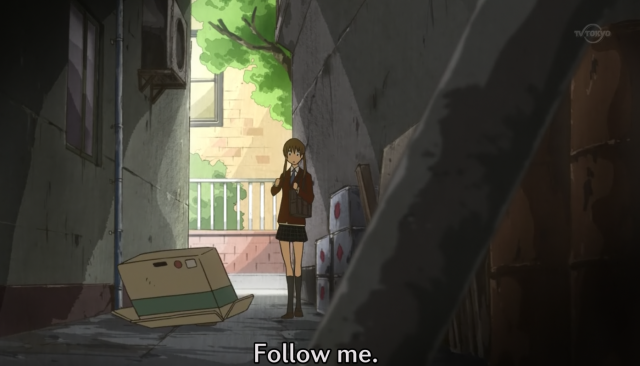
Haru is a slippery snake.
Oh look, another anime high school romantic comedy with archetypical jerk characters.
The main difference between Tonari no Kaibutsu-kun and other series of its ilk is that this one is actually kind of funny and endearing. Sure, it’s nothing special so far, but to give credit where it’s due, I somehow found myself enjoying this first episode a bit in spite of its banality. This is most likely the result of Brains Base’s usual charms; the colorfully vibrant character designs and background art, coupled with some speedy animation, result in something that is definitely fun to watch even if it is lacking a bit in substance. I am also under the impression that this show takes place in the same universe as Ed, Edd n Eddy, since apparently Rolf’s chickens are running wild everywhere.
Assuming the diabetes-inducing OP does not send you into a coma, in this first episode you will be introduced to protagonist Mizutani Shizuku and love interest Yoshida Haru. Shizuku is exceptionally cold and seems to only care about herself, while Haru comes across as abrasive but turns out to be quite sweet under it all. This is, of course, groundbreaking territory for a romance – an anime one especially. They do play off of each other well enough, though, so if you’re a fan of romantic comedies, you’ll probably want to give this a watch.
The humor is hit and miss – more hits than misses, for what it’s worth – but I was somewhat taken aback by a creepy off-the-cuff rape joke halfway through that doesn’t appear to disturb Shizuku in the slightest. Lines such as these seem to pop up quite often in shoujo, which I find shocking since I doubt the target audience wants to see the male love interest make “witty” remarks about sex crimes.
Around the 20 minute mark, I began to question whether or not I was liking what I’d seen so far. And I think that’s the biggest problem with Tonari no Kaibutsu-kun’s first episode… it doesn’t really leave an impression, good or bad. It just exists. You can watch it, or maybe not, whatever.
But seriously, what’s up with the chickens? 6/10 – Foggle
Zetsuen no Tempest

Actually, that’s an island. *rimshot*
Zetsuen no Tempest is nothing if not atmospheric. It’s a show with a few glaring flaws, the most obvious of which being the occasional groan-inducing, ham-fisted Shakespeare reference, but even with its problems laid out front and center, Tempest’s audio-visual design goes a long way toward making its world feel real and characters compelling. On the surface, there is a lot to dislike here, and almost immediately I concluded that this would not be a series I’d appreciate – however, my thoughts on it changed drastically over the course of the first episode’s 24 minute runtime.
Episode 1 is a bit hard to follow at first, though mercifully almost everything becomes clear by the time the credits roll. Zetsuen no Tempest follows the exploits of androgynous high-schooler Takigawa Yoshino, a seemingly normal guy with a couple of complex relationships and a knack for various forms of manipulative trickery (basically, he’s really good at lying); a more interesting protagonist than many of his analogues, to be sure. Revealing any actual plot details would spoil the numerous developments and twists of this first installment, but suffice it to say that the typical tropes of fantasy anime come into play here before too long. There’s some magic usage, some time skips, some sea monsters, a secret agent wearing a short skirt in winter… pretty much everything we’ve come to expect from show like this. Of course, what Tempest lacks in originality, it makes up for in presentation. The action is crisp, the music enjoyable, and the environments (cold open aside) sublime.
Initially, I felt that the supernatural elements detracted from the overall story, but they grew on me before too long. I’m still not sure whether or not they add anything to it, as certain situations would have been made more interesting without teleportation or forcefields, but they don’t really hurt the concept at all in the long run. At the same time, I do feel that – if written well – Yoshino and his interactions with other characters alone could have successfully carried a more down-to-earth series, though that is neither here nor there.
Many of my problems with Tempest stem from the dialogue feeling unnatural. The Shakespeare references are completely out of place and seem to have been inserted for the sole purpose of attempting to appear intelligent. Certain other lines also try to come across as “deep”, only to sound either bizarre or just plain stupid. Meanwhile, the underlying plot about an evil mage trying to kill one more powerful than himself is not exactly enticing (yet) and leaves me with little reason to care about what happens next. That said, this series has left a good enough first impression for me to want to check out the next episode… eventually.
Zetsuen no Tempest isn’t something I’d wholeheartedly recommend, but it’s certainly much better than appearances suggest and just might be worth watching. 7/10 – Foggle
TL;DR
YOU’LL LOVE IT
Psycho-Pass – 9/10
JoJo’s Bizarre Adventure – 8.5/10
Chuunibyou demo Koi ga Shitai! – 8/10
Little Busters! – 8/10
DEFINITELY MAYBE
Zetsuen no Tempest – 7/10
Resident Evil: Damnation – 6/10
Tonari no Kaibutsu-kun – 6/10
K – 5/10
Ixion Saga DT – 4.5/10
DON’T BOTHER
Btooom! – 4/10
Medaka Box Abnormal – 3/10
Robotics;Notes – 3/10
Onii-chan Dakedo Ai Sae Areba Kankeinai yo ne (OniAi) – 1/10
———
Our Rating Scale
Many websites rate shows on a scale of 7-10, with the other 6 numbers on there simply for posterity’s sake. That’s fucking stupid. We here at AR proudly use roughly 250% as many numbers as IGN when scoring anime!
10 – Masterpiece
9 – Superb
8 – Great
7 – Good
6 – Above Average
5 – Average
4 – Below Average
3 – Bad
2 – Terrible
1 – Unwatchable
